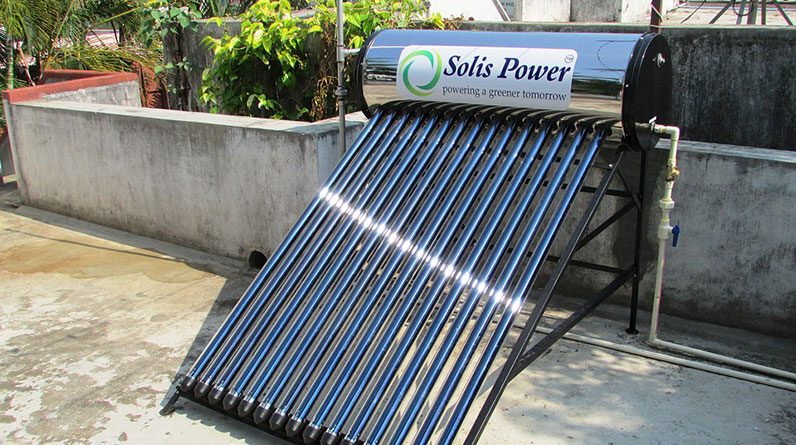
Solar Powered Water Heater
Heating your water using solar power can be a cost-effective way to do so. In this article we will discuss the things you need to know about using solar power to heat water at home, from the pros and cons of different solar hot water systems to information on installation costs and maintenance expenses. The goal of this article is to provide you with the details you need to make an informed decision about whether or not solar heating is right for you in your specific circumstances.
What is Solar Hot Water?
Solar hot water (SWH) is a system for heating water that uses solar power to produce high-temperature (thermal) energy that is then transferred to a heat exchanger.
The exchanger is connected to a water storage tank in order to heat the water in the tank. The water in the tank can then be used for a variety of purposes, such as to heat your home, to water your garden, or wash your car.
Solar hot water systems come in several different configurations that vary in the way they use solar energy to generate thermal energy and transfer it to the water. In this article, we will focus on the most common type of SWH, the combination system.
How Does Solar Water Heating Work?
The combination system consists of a solar collector, a heat exchanger, a pump, an expansion tank, and a water storage tank. The solar collector is located on your roof, and it is where the thermal energy is generated.
Depending on the type of collector you use, the solar collector will either use convection or a combination of condensation and radiation to produce high-temperature thermal energy.
The heat exchanger is located in a garage or a utility room, and it is where the thermal energy is transferred to water. The pump is used to transfer the water between the storage tank and the heat exchanger. The expansion tank is used to regulate pressure in the system. The water storage tank is where the heated water is stored until you need to use it.
Advantages of Using Solar Power to Heat Water
There are many advantages associated with using solar power to heat water at home. First, solar hot water systems produce zero emissions, so they are a sustainable and environmentally friendly way of heating water.
Additionally, SWH systems are much cheaper to install than solar photovoltaic (PV) systems for generating electricity, so they can save you money in the long run.
Finally, solar hot water systems provide a reliable source of renewable energy. On average, the sun provides enough energy to meet all of our global energy demands in just one hour. This means that solar hot water systems are a reliable source of energy that can be used whenever needed to heat water.
Disadvantages of Using Solar Power to Heat Water
Solar hot water systems do have some drawbacks. First, they don’t work when it is cloudy. Since the system relies on sunlight to generate thermal energy, it can’t heat water when there is no sunlight.
The collector will only be able to produce low-temperature thermal energy during this time, which isn’t enough to heat water. In order to heat water when it is cloudy, you would need to use a different system, such as gas or electricity.
Another drawback of the solar hot water system is that it is only a cost-effective solution for heating water in moderately sunny regions. Solar hot water systems work best in regions like the south or southwestern United States where there is plenty of sunshine year-round. In regions with less sunny weather, solar hot water systems won’t be able to produce enough thermal energy to heat water year-round.
Installing a Residential Solar Hot Water System
The first step in installing a residential solar hot water system is to determine the best configuration for your specific circumstances. There are three main types of solar collectors that can be used in combination with various types of heat exchangers.
Once you have decided on the best configuration for your home, you can shop around for the best solar hot water system that is both cost-effective and high-quality. Once you have purchased the system, it is time to install it.
The installation process will vary depending on the type of system you have purchased.
But in general, you will need to do the following:
- Position the solar collectors on your roof – Depending on the system, you may also need to position additional collectors on the roof. Collectors are connected to the piping that transfers thermal energy to the heat exchanger.
- Install the heat exchanger – This includes connecting the heat exchanger to the piping and to the water storage tank.
- Connect the system to the water supply – This includes connecting the water supply to the pump and the water supply to the heat exchanger.
- Connect the system to the water drainage system – This includes connecting the drainage system to the pump and the drainage system to the heat exchanger.
- Test the system to make sure it is working properly – This can include testing the pressure and flow rates in the system.
Conclusion
Solar hot water systems are a sustainable and environmentally friendly way of heating water at home. They are a cost-effective solution for those living in moderately sunny regions.
Solar hot water systems are a reliable source of renewable energy that can be used whenever needed to heat water. However, solar hot water systems don’t work when it is cloudy. In order to heat water when it is cloudy, you would need to use a different system, such as a gas or electricity.